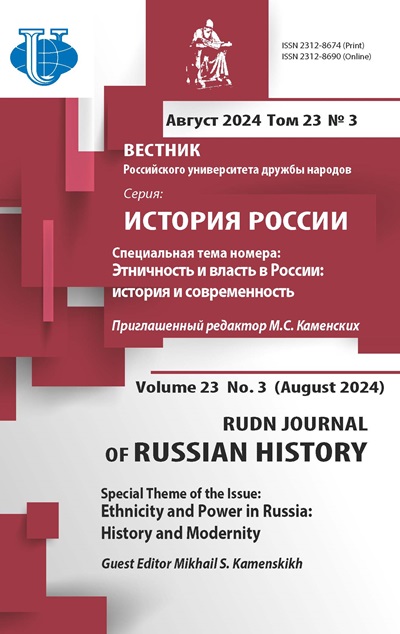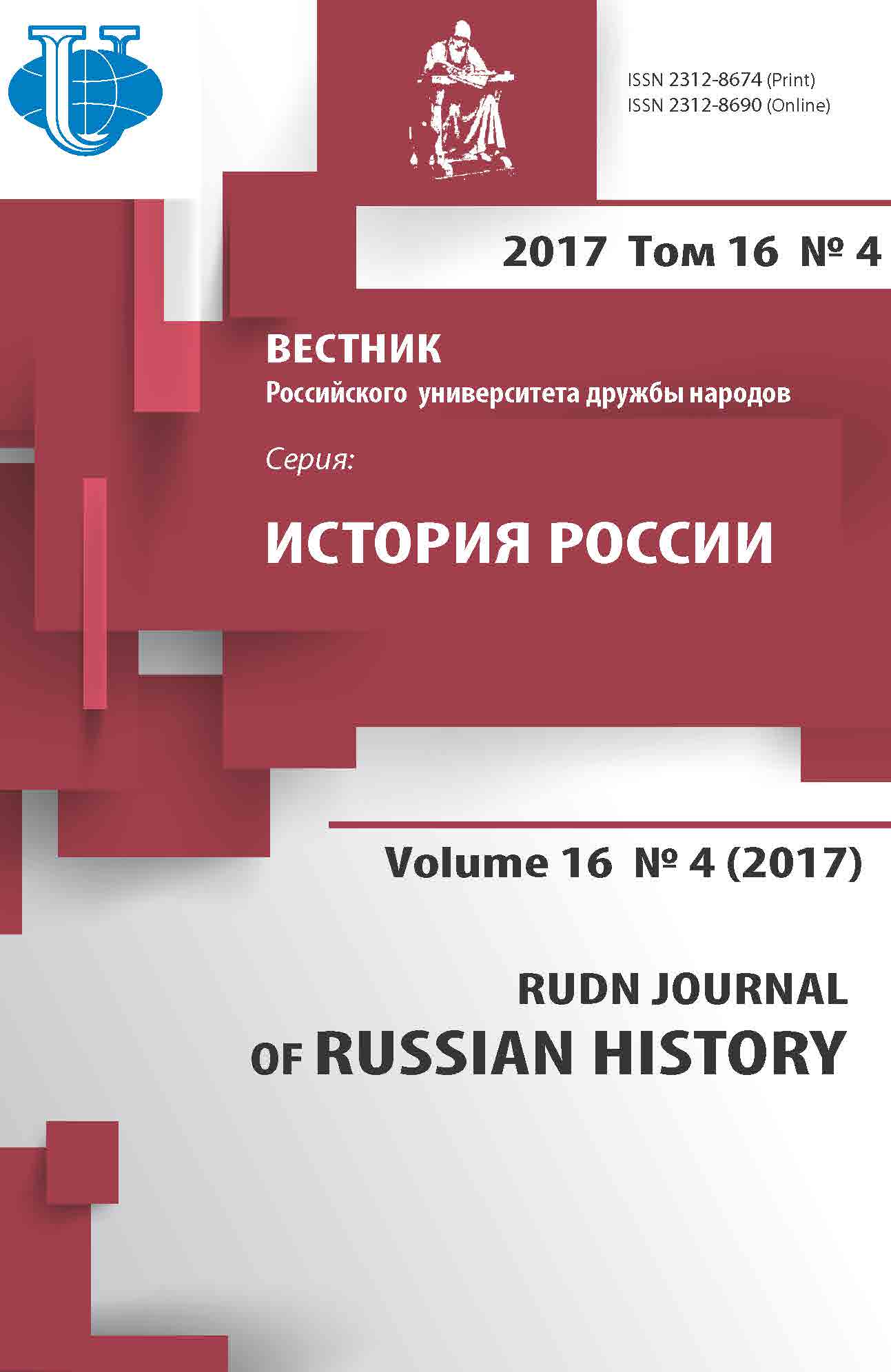WOMEN AND THEIR WAY OF LIFE IN USSR IN 1950-1960SIN SOVIET AND MODERN RUSSIAN HISTORIOGRAPHY
- Authors: Ryabkova E.S1
-
Affiliations:
- Institute of Ethnology and Anthropology of the Russian Academy of Sciences named after Nicholas Miklouho-Maclay
- Issue: Vol 16, No 4 (2017)
- Pages: 670-685
- Section: ARTICLES
- URL: https://journals.rudn.ru/russian-history/article/view/17465
- DOI: https://doi.org/10.22363/2312-8674-2017-16-4-670-685
Cite item
Full text / tables, figures
Abstract
The urgency of the reference to the historiography of the issue of Soviet women’s every-day life during the thaw period is explained by the preservation of the image of the woman of the post-war society - mother, wife and worker - at the present time. Studies of this multi-role image have not only scientifi c, but also practical signifi cance. This article examines the views of Soviet and modern Russian historians on the way of life of Soviet townswomen. Being in different ideological conditions, researches tried to reconstruct the history of Soviet women and their way of life using various approaches to the studies. This historiographical review makes it possible not only to determine the periodization, but also to fi nd out common and special characteristics in the scientists’ views of Soviet women’s way of life. As a result of the research, the author singles out four historiographical periods. The fi rst stage from the 1950s to the mid-1960s was characterized by the desire of researchers to prove that the “women’s issue” in the USSR was successfully solved, as well as to demonstrate the care for women on the part of the state. Due to the researchers’ enthusiasm for studying these aspects, the issue of women’s non-offi ce hours became secondary. The historiographical pe-riod from the mid-1960s to the early 1980s was similar to the previous stage. However, 1975 proclaimed the Year of Women, conditioned the increase of sociologists and historians’ inter-est in the “time budget” issue of Soviet townspeople in their everyday life. In the period from the second half of the 1980s and throughout the 1990s, there was an increase in the range of sources. Besides that, there appeared new approaches to researching women’s everyday life. The present stage, beginning from the 2000s, is characterized by the most diverse studying of the details of women’s daily life: clothes, furniture, housing conditions, reproductive health, the microclimate in Soviet families and motherhood.
About the authors
Ekaterina S Ryabkova
Institute of Ethnology and Anthropology of the Russian Academy of Sciences named after Nicholas Miklouho-Maclay
Author for correspondence.
Email: katerinapositiv@gmail.com
Ryabkova Ekaterina Sergeevna, postgraduate student of the Institute of Ethnology and Anthropology of the Russian Academy of Sciences named after N.N. Miklouho-Maclay (Moscow, Russia)
119334 Russia, Moscow, Leninsky prospect, 32AReferences
- Bol’shaya sovetskaya ehnciklopediya [The Great Soviet Encyclopedia]. Moscow: Nauka Publ. 1970. Vol. 3 (in Russian).
- Aralovec HD. Zhenskij trud v promyshlennosti SSSR [Women’s labor in the soviet industry]. Moscow: Profi zdat Publ.; 1954 (in Russian).
- Abramova AA. Ohrana trudovyh prav zhenshchin v SSSR [Protection of women’s labor rights in the USSR]. Moscow: G’osyurizdat Publ.; 1954 (in Russian).
- Bil’shaj VL. Reshenie zhenskogo voprosa v SSSR [The solution of the women’s issue in the USSR]. Moscow: Gospolitizdat Publ.; 1959 (in Russian).
- Ovsyannikova MD. Fakty i cifry o polozhenii zhenshchin v SSSR [Facts and fi gures about the situation of women in the USSR] Moscow: 1954 (in Russian).
- Us AP. Chto dala sovetskaya vlast’ zhenshchinam [What did Soviet government give to women?]. Minsk: Gosizd BSSR Publ.; 1950 (in Russian).
- Zueva TII. Rol’ sovetskih zhenshchin v razvitii nauki, kul’tury i iskusstva [The role of Soviet women in the development of science, culture and art]. Moscow: 1956 (in Russian).
- Kuprin O. Byt – ne chastnoe delo [Life is not a private matter]. Moscow: Profi zdat Publ.; 1959 (in Russian).
- Matveev DS. Doch’ zavoda [Daughter of factory]. Orenburg: Orenburgskoe knizhnoe izdatelstvo Publ.; 1962 (in Russian).
- Gorbachev AB. Devushka iz Rossii [Girl from Russia]. Orenburg: Orenburg Publ.; 1962 (in Russian).
- Ovchinnikova IN. Sovetskie zhenshchiny aktivnye stroiteli kommunizma [Soviet women are active builders of communism]. Leningrad: Len-izdat Publ.; 1961 (in Russian).
- Beloglazova GV, Savinova LN. Sovetskaya zhenshchina – aktivnaya uchastnica kommunisticheskogo stroitel’stva [The Soviet woman is an active participant in the communist construction]. Moscow: 1977 ( in Russian).
- Gordon LA, Rimashevskaya NM. Pyatidnevnaya rabochaya nedelya i svobodnoe vremya trudyashchihsya [Five-day working week and free time for workers]. Moscow: Mysl‘ Publ.; 1972 (in Russian).
- Grushin BA. Svobodnoe vremya: Aktual’nye problemy [Leisure time: Actual questions]. Moscow: Mysl’ Publ.; 1967 (in Russian).
- Gordon A, Voz’mitel’ A, Zhuravleva I, Klopov Eh, Rimashevskaya N, Yadov V. Sociologiya byta, zdorov’ya i obraza zhizni naseleniya [Sociology of life, health and lifestyle of the population]. Sociologiya v Rossii. Moscow: RAN Publ.; 1998: 438−445 (in Russian).
- UN and women. United Nations. Available at: http://www.un.org/ru/sections/issuesdepth/women/index.html (Data of access 12.07.2017).
- Chumanenko VG. Polozhenie zhenshchiny pri kapitalizme [The position of women under capitalism ]. Moscow: 1975 (in Russian).
- Belova VS. Polozhenie zhenshchin v SSSR [The position of women in the USSR]. Moscow: 1975 (in Russian).
- Zujkova EM., Plaksina NN. Reshenie zhenskogo voprosa v SSSR i ego mezhdunarodnoe znachenie [The solution of the women’s issue in the USSR and its international signifi cance]. Moscow; 1976 (in Russian).
- Novikova EhE., Yazykova VS., Yankova ZA. Zhenshchina. Trud. Sem’ya [Female. Work. Family]. Moscow: Profi zdat Publ.; 1977 (in Russian).
- Gordon L, Klopov EH, Onikov L. Social’nye problemy byta [Social problems of daily life]. Kommunist. 1974; (17): 49−60 (in Russian).
- Novikova EhE, Sidorova TN, Turchaninova SYA. Sovetskie zhenshchiny i profsoyuzy [Soviet women and trade unions]. Moscow: Profi zdat Publ.; 1984 (in Russian).
- Krylova ZP. Sovetskaya zhenshchina: trud, materinstvo, sem’ya [Soviet woman: work, motherhood, family]. Moscow; 1987 (in Russian).
- Kostakov V. Zhenskaya rabota [Women’s work]. In: Krylova Z.P., Akivis D.S., Kostygova T.M., Zhuravskaya I.A. Sovetskaya zhenshchina: trud, materinstvo, sem’ya [Soviet woman: work, motherhood, family]. Moscow; 1987: 48−49 (in Russian).
- Ajvazova S. Idejnye istoki zhenskogo dvizheniya v Rossii [The ideological roots of the women’s movement in Russia]. Obshchestvennye nauki i sovremennost’. 1991; (4): 20−25 (in Russian).
- Pankratova MG. Russkaya zhenshchina segodnya [Russian woman today]. Zhenshchiny Rossii vchera, segodnya, zavtra [Russian women yesterday, today and tomorrow]. Moscow: 1994: 12−24 (in Russian).
- Kozlova NH. Sovetskaya predstavitel’naya sistema: k voprosu uchastiya zhenshchin v deyatel’nosti mestnyh organov vlasti [The Soviet representative system: to the issue of women’s participation in the activities of local authorities]. Zhenshchiny v social’noj istorii Rossii: sbornik nauch trudov [Women in Russian social history: collection of scientifi c works]. Tver’: TGU Publ.; 1997: 12−20 (in Russian).
- Hasbulatova OA. Etapy rossijskoj gosudarstvennoj politiki po vovlecheniyu zhenshchin v sferu gosudarstvennogo upravleniya (1990−1999 gg.) [Stages of the Russian state policy on the involvement of women in public administration (1990–1999)]. Zhenshchina v rossijskom obshchestve. 1999; (3): 33 −42 (in Russian).
- Petrov MS. Ehvolyuciya obraza rabotayushchej zhenshchiny v otechestvennoj zhurnalistike (po materialam zhurnala «Krest’yanka») [Evolution of the image of a working woman in domestic journalism (based on the journal “Krestyanka”]. Trud i social’nye otnosheniya. 2010; (5): 47−49 (in Russian).
- Gamel’ko EV. Obraz sovetskoj zhenshchiny na stranicah zhurnala «Rabotnica» [The image of a Soviet woman in the pages of the magazine “Rabotnitsa”]. Molodoj uchenyj. 2009: 174−177 (in Russian).
- Smeyuha VV. Processy identifi kacii i zhenskaya pressa [Identifi cation processes and women’s press]. Rostov-na-Donu. 2012: 58−59 (in Russian).
- Shabatura EA. Obraz sovetskoj zhenshchiny v zhurnalah «Kommunistka» i «Krasnaya sibiryachka» [The image of a Soviet woman in the journals “Kommunistka” and “Krasnaya Sibiryachka”]. Adam i Eva. Al’manah gendernoj istorii. 2004; (8): 138−149 (in Russian).
- Dashkova T. Ideologiya v licah. Formirovanie vizual’nogo kanona v sovetskih zhenskih zhurnalah 1920−1930 gg. [Ideology in the faces. Formation of the visual canon in Soviet women’s magazines in 1920s − 1930s]. Kul’tura i vlast’ v usloviyah kommunikacionnyh revolyucij 20 veka. Forum nemeckih i rossijskih issledovatelej [The culture and the power under conditions of communistic revolution in the 20 th century. The forum of German and Russian researchers]. Moscow; 2005: 139−145 (in Russian).
- Usmanova A. Vizual’nyj povorot» i gendernaya istoriya [“Visual Turn” and the gender History]. Gendernye istorii Vostochnoj Evropy. Sbornik nauchnyh statej [английский перевод]. Minsk; 2002: 36−57 (in Russian).
- Hasbulatova O. Rossijskaya gendernaya politika v 20-m stoletii: mify i realii. [Russian Gender Policy in the 20th Century: Myths and Realities]. Ivanovo: Ivanovskii gos. universitet Publ.; 2005: 254−255 (in Russian).
- Gradskova Yu. Diskurs «social’nogo materinstva» i povsednevnye praktiki v 1930– 1950 gg [Discourse of “social motherhood” and everyday practices in the 1930s − 1950s]. Nuzhda i poryadok: istoriya social’noj raboty v Rossii v 20 veke [The order and the need: history of social work in Russia in the 20 th century]. Moscow, Saratov; 2005: 304−315 (in Russian).
- Chernova Zh. Semejnaya politika v Evrope i v Rossii: gendernyj analiz [Family policy in Europe and in Russia: gender analysis]. St-Petersburg: Norma Publ; 2008: 110–115 (in Russian).
- Grigor’eva A.G. Sovetskaya povsednevnost’ i uroven’ zhizni naseleniya SSSR v 1953–1964 gg. Avtoreferat kand. Dissertacii [Soviet everyday life and living standards of the population of the USSR in 1953s – 1964s. Abstract of Cand. dissertation]. Moscow: MGU Publ.; 2003: 5−6 (in Russian).
- Lebina NB, Chistikov AN. Obyvatel’ i reformy. Kartiny povsednevnoj zhizni gorozhan v gody nehpa i hrushchevskogo desyatiletiya [Philistine and reform. Pictures of everyday life of the townspeople during the NEP and Khrushchev’s decade]. St-Petersburg; 2003 (in Russian).
- Pushkareva NL. Gendernaya sistema v Rossii 20 veka i sud’by rossiyanok [The gender system in Russia in the 20th century and the fates of Russian women]. Novoe literaturnoe obozrenie. 2012; 117(5): 8−24 (in Russian).
- Belova AV. Zhenskaya povsednevnost’ kak predmet ehtnologicheskogo izucheniya [Female everyday life as a subject of ethnological study]. Etnografi cheskoe obozrenie. 2004; (4): 86−95 (in Russian).
- Vinichenko IV. Sovetskaya povsednevnost’ 50-h – serediny 60-h gg. XX veka :zhenskij kostyum v modelyah odezhdy i bytovoj praktike. Avtoreferat kand. dissertacii [Soviet everyday life of the 50’s – the mid-60’s. XX century: women’s costume in the models of clothing and household practices. Abstract of Cand. Dissertation]. Omsk: Omskii gosudarstvennii universitet Publ.; 2009: 4−5 (in Russian).
















